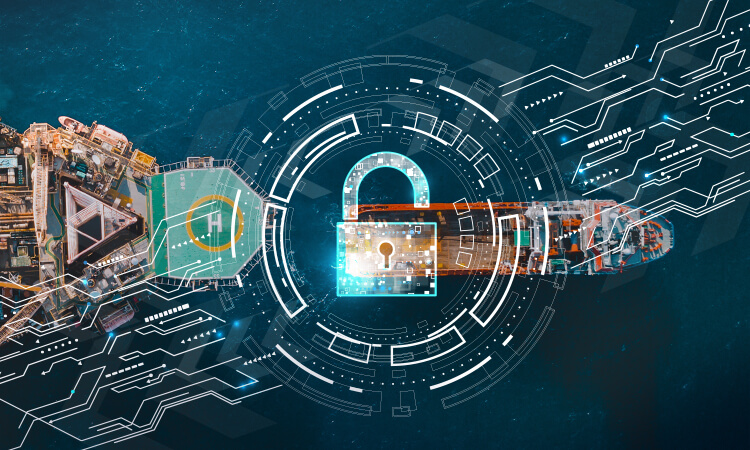With digitalisation, the maritime sector is actively optimising its operations, increasing its productivity, and reducing its costs. This push towards digitalisation goes hand-in-hand with the growing demand for uninterrupted connectivity services onboard all types of vessels. While this is becoming vital to business continuity in a hyper-competitive global business environment, it is also increasing the exposure to cyber risks and potential service disruptions.
In light of these evolving factors, the International Maritime Organisation (IMO) adopted an International Safety Management (ISM) Code, in effect from January 2021. This resolution put forth a set of compliance recommendations to address existing safety management systems, especially noting that commercial ships with over 500 gross tonnage are required to include cyber security in their onboard management systems.
Since then, fleets across the globe have been – and are continuing to be – surveyed by third-parties to empower vessel owners with a comprehensive understanding of the cyber security exposure of their vessel. In fact, cyber security is now progressively becoming a part of formal maritime contracts. Onboard cyber security today is not just a matter of IMO compliance, but an inherent part of management strategy and the fleet planning process.
From 2016 to 2021, 13 high-level and significant cyber incidents were reported in the global maritime industry. Since then, cyber-attacks in operational technology (OT) systems have increased by 900%. This means that the onboard network that manages traffic control, cranes, vessel berthing, cargo handling, safety, and security is severely exposed and can be potentially compromised. Moreover, an OT system disruption can easily spill over into the vessel’s IT system – bringing cyber operations and vessel security to a standstill.
In the last year alone, there have been 5 significant maritime cyber incidents – and these are becoming more sophisticated and malicious. In 2020, security breaches cost $4 million – an all-time record. The average cost of a data breach is expected to surpass $5 million in 2023.
Besides onboard cyber risks, today’s operational landscape includes the management of large volumes of critical data. From ship-to-shore data transfers to real-time remote vessel monitoring, maritime services are delivered over digital systems that function over both GSM and satcom. Connectivity is also a risk to the maritime supply chain. A single cyber-attack can affect multiple fleets and companies at once.

Earlier this year, the IMO has revised its emissions strategy for the maritime sector – aiming for net zero by 2050. A checkpoint for a 40% decrease in GHG emissions has been marked for 2030. Certifications for Energy Efficiency Existing Ship Index (EEXI) and Carbon Intensity Index (CII) are mandatory since January 2023.
Essentially this means that a vessel’s operational processes will have to include such data reporting – especially keeping in mind that the IMO is actively updating co mpliance requirements across emissions as well as safety and cyber security systems. It is, thus, pertinent that the authenticity and security of data and cyber systems is maintained.
Fortunately, such cyber secure data collection has shown that, in the past three years, the maritime industry has increased the use of clean fuels, reduced air pollution, and decreased sulphur oxide emissions by 77%. A parallel uptake in cyber security policies and multi-layer coverage for fleets – anti-virus, risk control, and advanced threat protection – bodes well for the challenges being faced by the maritime sector.
The IMO has defined five areas of cyber security measures to ensure that critical vessel systems are not compromised.

Ensuring efficiency in cost and time, as well as maintaining the integrity of transferred data, is at the core of IEC Telecom’s cyber security solutions. These comprehensive cyber security packages are specially optimised for the maritime environment and employ multiple layers of protection to shield on-board systems from known viruses and identify potential threats.
IEC Telecom is committed to supporting maritime companies in covering a wide range of IMO requirements. Our cyber security package includes:
Keeping each vessel’s software up-to-date is vital for the cyber security of the entire fleet. IEC Telecom offers remote deployment of software update patches and facilitates data replication between the ship and shore to enhance cyber security measures.

OptiShield offers top-tier protection for the onboard network as well as support in enforcing IMO compliance on the vessel. It is a unique cyber security offering in the market today with its 24/7 cyber response team that ensures timely and critical action against cyber-attacks. Its advanced IPS service utilises the latest threat intelligence in the market.
Vessel operators can enhance visibility and control inventories over an intuitive dashboard – investigate incidents in real-time and establish policies for automated responses. The seamless integration between the endpoint anti-virus and the next-generation firewall provides native endpoint visibility, vulnerability management, and compliance control.
OptiShield offers centralised system management. From automatically sharing data with customer endpoints to conducting sandbox analysis, administrators can quickly contain incidents and prevent further outbreaks.
IEC Telecom’s cyber security solutions come with advanced remote management capabilities. Not every vessel can have an IT specialist on board, which increases its vulnerability. IEC Telecom closes the gap, enabling remote support throughout the vessel’s journey. Satcom consultancy is not limited to security alone, but also helps customers to optimise traffic consumption, saving costs and improving the customer experience.